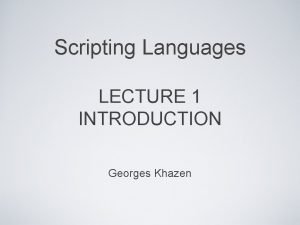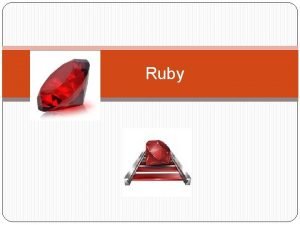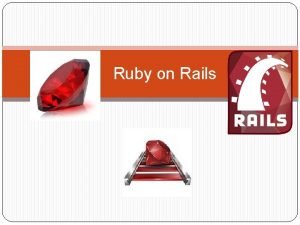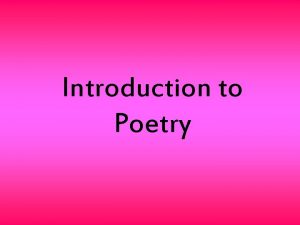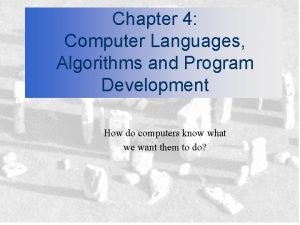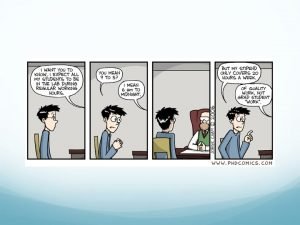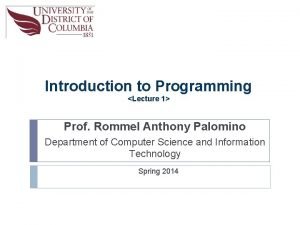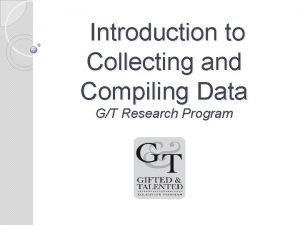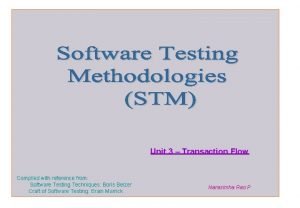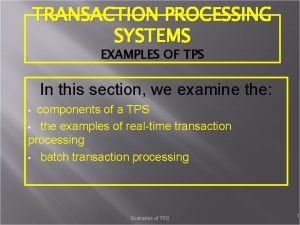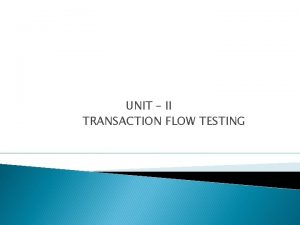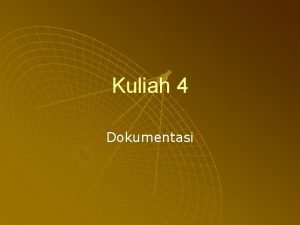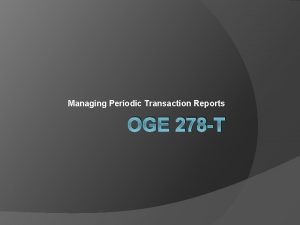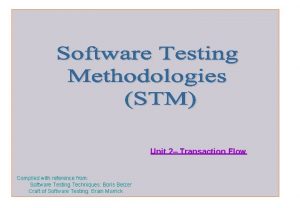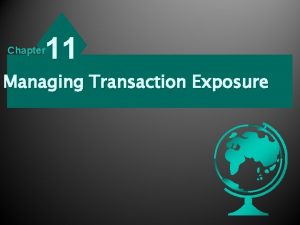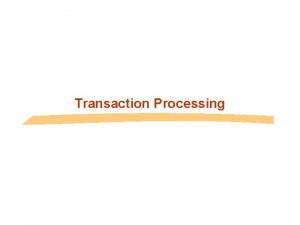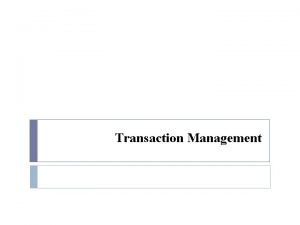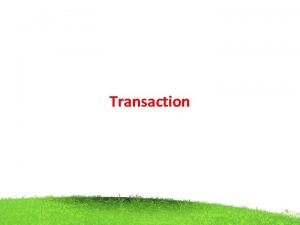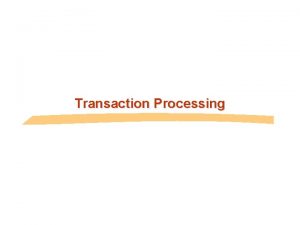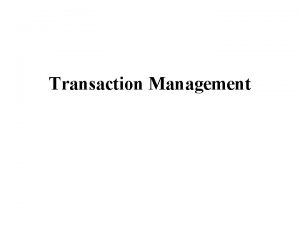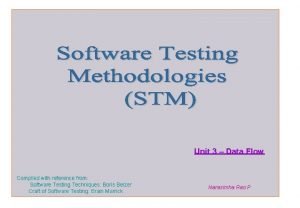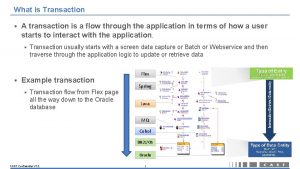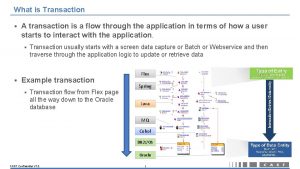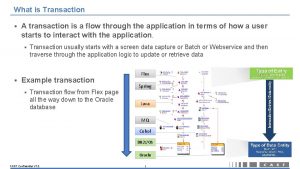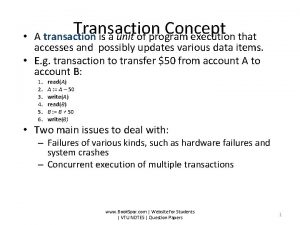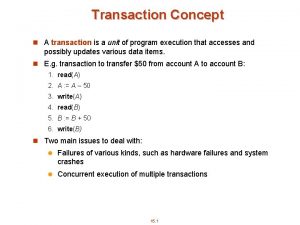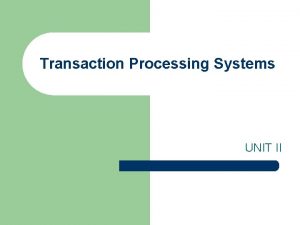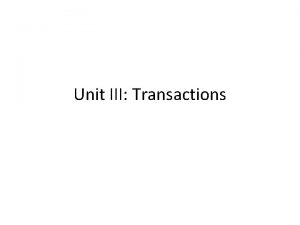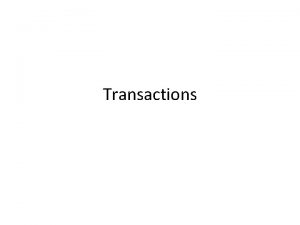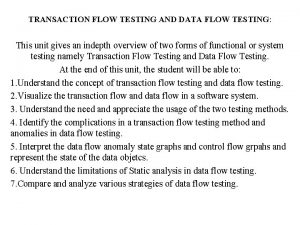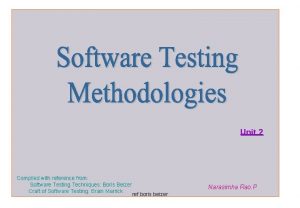Unit 3 Transaction Flow Compiled with reference from































- Slides: 31

Unit 3 – Transaction Flow Compiled with reference from: Software Testing Techniques: Boris Beizer Craft of Software Testing: Brain Marrick Narasimha Rao. P ref boris beizer 1

Transaction-Flow Testing U 2 We will see in this part of Unit 2: • Concepts of Transaction flows • Transaction-flow testing ref boris beizer 2

Transaction-Flow Testing U 2 Contents 1. Definitions of Transaction, Transaction flow graph 2. It’s representation, implementation architecture in an O. S. & implementation in a system 3. A perspective of TFG model. View wrt DFG, CFG 4. Handling cases – decisions, biosis, mitosis, transactional junction, absorption & conjugation 5. TFG is not structured - Reasons Transaction Flow Testing Techniques 1. 2. 3. 4. 5. 6. Building transaction flows Inspections, Reviews, and walkthroughs Path selection Path sensitization Instrumentation Test data bases 7. Test Execution 8. Transaction-flow implementation & testing related comments 1. Translation based systems 2. Hidden languages ref boris beizer 3

Definitions of Transaction, Transaction-flow, TFG U 2 Transaction-flow represents a system’s processing. Functional testing methods are applied for testing T-F. Transaction-flow Graph TFG represents a behavioral (functional) model of the program (system) used for functional testing by an independent system tester. Transaction • is a unit of work seen from system’s user point of view. • consists of a sequence of operations performed by a system, persons or external devices. • is created (birth) due to an external act & up on its completion (closure), it remains in the form of historicalref records. boris beizer 4

A Simple Transaction U 2 -B Example: the sequence of steps in a transaction in an online information retrieval system 1. accept inputs 7. Accept Inputs 2. Validate inputs (Birth of tr. ) 8. Validate inputs 3. Transmit ack. to the user 9. Process the request 4. Process input 10. Update file 5. Search file 11. Transmit output 6. Request direction from user 12. Record transaction in log & cleanup (Closure) Users View of a transaction : Single step Systems view : Sequence of many operations ref boris beizer 5

Example of a Transaction flow (diagram) User (terminal) Terminal controller U 2 CPU cancel User Begin order Request Type Request order from CPU Accept Order from CPU Process Form B help Y B Transmit Page to terminal D CPUAccept Confirm C Accept Input Field Y Valid ? More Fields? Transmit To CPU N More Pages ? Transmit Diagnostic to Terminal ref boris beizer User wants Review? C D N Done Set up Review 6

Definitions Transaction-flow Graph : a scenario between users & computer Transaction-flow an internal sequence of events in processing a transaction : U 2 Uses of Transaction-flow Specifying requirements of big, online and complicated systems. Airline reservation systems, air-traffic control systems. Loops are less as compared to CFG. Loops are used for user input error processing ref boris beizer 7

Implementation of Transaction-Flow (in a system) U 2 • Implicit in the design of system’s control structure & associated database. • No direct one-to-one correspondence between the “processes” and “decisions” of transaction-flow, and the corresponding program component. • A transaction-flow is a path taken by the transaction through a succession of processing modules. • A transaction is represented by a token. • A transaction-flow graph is a pictorial representation of what happens to the tokens. D Input S A S B S C S S Output E S : Scheduler A, B, C, D, E : Processes ref boris beizer 8

Implementation of Transaction-Flow U 2 System Control Structure (architecture of the implementation) : Front End Input Queue Process Queues EXECUTIVE SCHEDULER - AND / OR DISPATCHER A Processor B Processor Output Queue OPERATING SYSTEM C Processor Output Module D Processor E Processor Application Processes Executive / Dispatcher Flowchart (a sample sequence) 1 Do All B’s Disc Reads Do All C’s Tape Writes Do All B’s Disc Writes 2 2 Do All D’s Disc Reads Do All A’s Tape Reads Do All E’s Disc Writes 1 ref boris beizer 9

Implementation of Transaction-Flow U 2 System control structure System is controlled by a scheduler … A Transaction is created by filling in a Transaction Control Block (TCB) by user inputs and by placing that token on input Q of Scheduler examines and places it on appropriate process Q such as A. When A finishes with the Token, it places the TCB back on the scheduler Q. Scheduler routes it to the next process after examining the token : 1. It contains tables or code to route a token to the next process. 2. It may contain routing information only in tables. 3. Scheduler contains no code / data. Processing modules contain code for routing. ref boris beizer 10

Implementation of Transaction-Flow Transaction Processing System U 2 (simplified): • There are many Tr. & Tr-flows in the system. • Scheduler invokes processes A to E as well as disk & tape read & writes. • The order of execution depends on priority & other reasons. Cyclic structure like in this example is common in process control & communication systems. The criteria for implementation mechanism depends on performance and resource optimization. ref boris beizer 11

A perspective of Transaction-Flow U 2 Transaction-flow testing is a block box technique. (as we assumed nothing regarding computer, communications, environment, O. S. , transaction identity or structure or state. ) 1. TFG is a kind of DFG. • TFG has tokens, & DFG has data objects with history of operations applied on them. • Many techniques of CFG apply to TFG & DFG 2. Decision nodes of TFG have exception exits to the central recovery process. 3. So, we ignore the effect of interrupts in a Transaction-flow. ref boris beizer 12

Transaction Flows – splitting & merging decisions Splits of transactions (Births) Alternative 2 1. A decision point in TFG Alternative 1 2. Biosis Parent Daughter Tr. 3. Mitosis Parent Daughter Tr. 13 ref boris beizer U 2 -B

Transaction Flows – splitting & merging decisions Mergers of transactions Path 1 1. Junction Continue Path 2 2. Absorption Daughter Tr. Predator 3. Conjugation Parent Daughter Parent 14 ref boris beizer U 2

TFG – splitting, merging Transactions U 2 NOTES: • Multiple meanings now for decision and junction symbols in a TFG. • Simple TFG model is not enough to represent multi-processor systems & associated coordination systems. • Petrinet model uses operations for all the above. But Petrinets are applied to H/W, N/W protocol testing – but not Software. 15 ref boris beizer

Simplified TFG model U 2 Simplify TFG model 16 • Add New Tr-Flows for Biosis, Mitosis, Absorption, Conjugation • Problems for programmer, designer & test designer. • Need to design specific tests – possibility of bugs. ref boris beizer

Transaction-flow Structure U 2 -B Reasons for Unstructuredness 1. Processes involve Human Users 2. Part of Flow from External Systems 3. Errors, Failures, Malfunctions & Recovery Actions 4. Transaction Count, Complexity. 17 Customer & Environment ref boris beizer

Transaction-flow Structure U 2 -B Reasons for Unstructuredness … 5. New Transactions, & Modifications 6. Approximation to Reality • Attempt to Structure 18 ref boris beizer

Transaction - Flow Testing - Steps U 2 -B First, Build / Obtain Transaction Flows • Represent Explicitly • Design details the Main Tr-Flows • Create From PDL • HIPO charts & Petrinet Representations Objective – Trace the transaction 19 ref boris beizer

Transaction - Flow Testing - Steps U 2 -B 1. Inspections, Reviews & Walkthroughs Start From Preliminary Design 1. Conducting Walkthroughs • Discuss enough Transaction Types (98% Transactions) ( • User needs & Functional terms (Design independent) • Traceability to Requirements 20 ref boris beizer

Transaction - Flow Testing - Steps U 2 -B 1. Inspections, Reviews & Walkthroughs … 2. Design Tests for C 1 + C 2 coverage 3. Additional Coverage (> C 1+C 2) • Paths with loops, extreme values, domain boundaries • Weird cases, long & potentially troublesome Tr. 4. Design Test cases for Tr. Splits & mergers 5. Publish Selected Test Paths early 6. Buyer’s Acceptance – functional & acceptance tests 21 ref boris beizer

Transaction - Flow Testing Techniques U 2 -B 2. Path Selection 1. Covering Set (C 1+C 2) of Functionally Sensible Tr. 2. Add Difficult Paths • Review with designers & implementers • Exposure of interface problems & duplicated processing • Very few Implementation bugs may remain Transaction-flow Path Covering Set belongs in System Feature Tests 22 ref boris beizer

Transaction - Flow Testing Techniques U 2 -B 3. Sensitization 1. Functionally Sensible Paths – Simple 2. Error, Exception, External Protocol Interface Paths - Difficult Testing Tr. –Flows with External Interfaces • Use patches & break points, mistune, and break the rules, 23 ref boris beizer

Transaction - Flow Testing Techniques U 2 -B 4. Instrumentation 1. Link Counters are not Useful. 2. Need • Trace • Queues on which Tokens resided • Entries to & Exits from Dispatcher • A Running Log Make Instrumentation as part of System Design 24 ref boris beizer

Transaction - Flow Testing Techniques U 2 -B 5. Test Data bases 1. Design & Maintenance of a Test Data base - Effort 2. Mistakes • Unawareness about design of a centrally administered test DB • Test DB design by Testers • Using one DB for all tests (need 4 to 5) Need experienced System & Test Designers 25 ref boris beizer

Transaction - Flow Testing Techniques U 2 -B 6. Test Execution 1. Use Test Execution Automation 2. Have to do a large # of Tests for C 1+C 2 coverage 26 ref boris beizer

Transaction - Flow Testing - Implementation U 2 -B 1. Transaction based systems • TCB 2. Centralized, Common Processing Queues • Just O(n) Queues for Links of O(n 2) 3. Transaction Dispatcher • Uses tables & Finite State Machines 4. Recovery & Other Logs • Key events in Tr – Flow 27 5. Self-Test Support • Privileged modes in Transaction control tables ref boris beizer

Transaction - Flow Testing - Caution U 2 -B Hidden Languages (flow control language) • Transaction Flows based on control codes in TCB or DB • Undeclared. Syntax & Semantics are not debugged. • Possibility of bugs 28 ref boris beizer

Software Testing Methodology U 2 To Unit 3 : Data flow testing … ref boris beizer 29

Data - Flow Testing - Basics U 2 • Data Flow Testing (DFT) uses control flow graph (CFG) to explore dataflow anomalies. • DFT is a family of test strategies based on selecting paths through the program’s control flow in order to explore the sequence of events related to the status of data objects. • For example: • Pick enough paths to assure that every data item has been initialized prior to its use, or that all objects have been used for something. 30 ref boris beizer

Data - Flow Testing - Basics U 2 Motivation • To feel confident about the program • Data dominated design. Code migrates to data. . • ½ of source code for Data Declarations • Data flow Machines vs Von Neumann’s • Abstract M I M D • Language & compiler take care of parallel computations • DFG is a spec. for relations among the data objects. Explore all relations under some test. 31 ref boris beizer
 Dfd to structure chart
Dfd to structure chart Transform flow and transaction flow
Transform flow and transaction flow Transaction flow graph
Transaction flow graph Strongly typed scripting language
Strongly typed scripting language Ruby is interpreted language
Ruby is interpreted language Compiled languages
Compiled languages Poetry v prose
Poetry v prose Interpreted vs compiled language
Interpreted vs compiled language Shell scripts are compiled or interpreted
Shell scripts are compiled or interpreted “interpreted vs compiled language”
“interpreted vs compiled language” Process of compiling data in research
Process of compiling data in research Transaction flow testing
Transaction flow testing Examples of tps system
Examples of tps system Example of transaction flow graph
Example of transaction flow graph Tps objectives
Tps objectives Relationship between transaction cycles
Relationship between transaction cycles 278 basic transaction flow
278 basic transaction flow Reference node and non reference node
Reference node and non reference node Reference node and non reference node
Reference node and non reference node Unit 10, unit 10 review tests, unit 10 general test
Unit 10, unit 10 review tests, unit 10 general test 4l fio2
4l fio2 Venturi mask 50 percent
Venturi mask 50 percent O2 mask types
O2 mask types Laminar flow and turbulent flow
Laminar flow and turbulent flow External flow
External flow Flow energy review
Flow energy review Oikos meaning
Oikos meaning Difference between rotational flow and irrotational flow
Difference between rotational flow and irrotational flow External flow vs internal flow
External flow vs internal flow Data flow vs control flow
Data flow vs control flow Production of cheese flow chart
Production of cheese flow chart Control flow and data flow computers
Control flow and data flow computers



